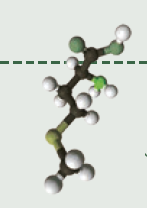Content available at:
Español (Spanish) Português (Portuguese (Brazil))
Oral lesions are particularly prevalent in layers and breeders and can originate from different etiological agents. 
Alkaline mycotoxins, such as type A trichothecenes, can cause epithelial lesions and increase the rate of cell turnover (see photo on the right).
Another factor related to food is granulometry, since small particles can obstruct the salivary ducts, causing subsequent oral lesions.
Other frequently ignored factors are, for example:
They can be caused by spikes in the concentration of methionine and other components of the food, which end up causing injuries of this type.

Positive samples to T-2 and / or DAS in the ingredients (ELISA) or the food (HPLC).
Origin of ingredients from a supplier / region with a history of T-2 / DAS contamination.
Histopathology: Proliferation of epithelial cells. Hepatic vacuolation.
Decline of productive indexes of the flock.
Corrective actions
Corroborate the average contamination levels.
Use an antimycotoxin additive at an adequate dosage.
Avoid contaminating silos and water / feed lines with stale, wet or moldy food.

Regarding pellets:> 20% of fines.
Mash feed: Check the mean geometric diameter of the particles.
Histopathology: Presence of inflammatory cells and bacteria.
No drop in the productive indexes of the flock.
Corrective actions
Readjust the pelletizing process.
Increase the sieving size.
Using ligands in the pellet to improve its quality.

Dripping from the methionine injector into the mash preparation tank.
Histopathology: Infiltration of inflammatory cells. Necrotic lesions.
No drop in the productive indexes of the flock.
Corrective actions
Clean / replace the injectors.
Potential causes
Acid injector dripping into mixer preparation tank.
Histopathology: Infiltration of inflammatory cells. Necrotic lesions.
No drop in the productive indexes of the flock.
Corrective actions
Clean / replace the injectors.
Adjust the dosage of organic acids.

Histopathology: Infiltration of inflammatory cells. Necrotic lesions.
Possible drop in the productive indexes of the flock.
Increased mortality.
Corrective actions
Supply vitamins with water.
Supply organic acids with water.
Increase the concentration of chlorine in the water.
Subscribe now to the poultry technical magazine
AUTHORS

Layer Longevity Starts at Rearing
H&N Technical Team
The Strategy for a Proper Infectious Bronchitis Control
Ceva Technical Team
Elevate Hatchery Performance with Petersime’s New Data-Driven Incubation Support Service
Petersime Technical Team
Maize and Soybean Meal Demand and Supply Situation in Indian Poultry Industry
Ricky Thaper
Production of Formed Injected Smoked Chicken Ham
Leonardo Ortiz Escoto
Antimicrobial Resistance in the Poultry Food Chain and Novel Strategies of Bacterial Control
Edgar O. Oviedo-Rondón
GREG TYLER INTERVIEW
Greg Tyler
Insights from the Inaugural US-RSPE Framework Report
Elena Myhre
Newcastle Disease: Knowing the Virus Better to Make the Best Control Decisions. Part II
Eliana Icochea D’Arrigo
Avian Pathogenic E. coli (APEC): Serotypes and Virulence
Cecilia Rosario Cortés
The Importance of Staff Training on Animal Welfare Issues in Poultry Industry
M. Verónica Jiménez Grez
Rodent Control is a Key Factor in Poultry Biosecurity and Sustainability
Edgar O. Oviedo-Rondón